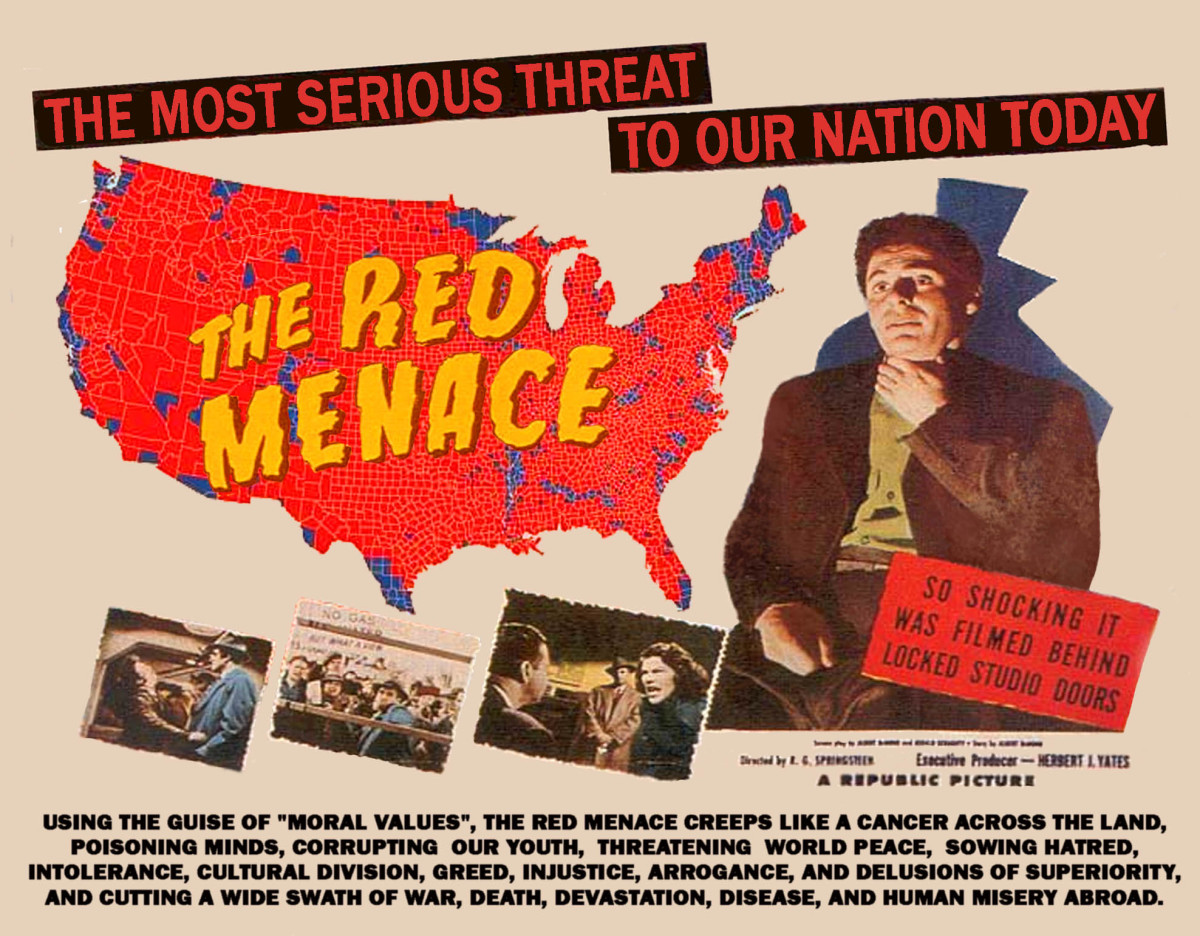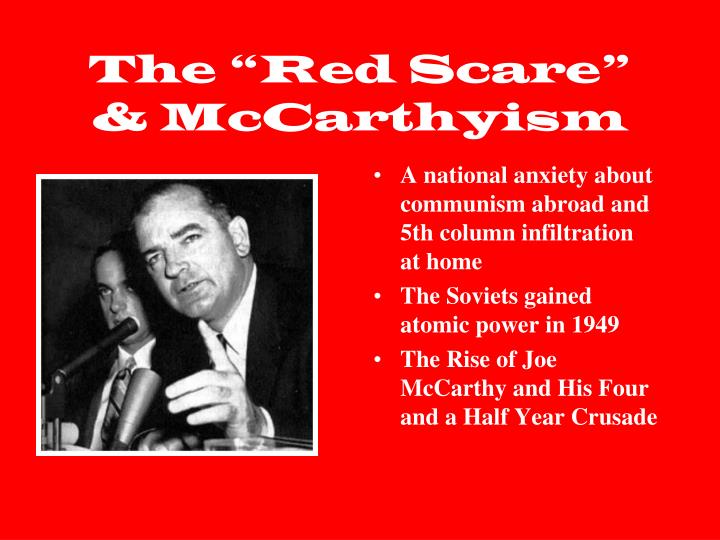Imagine a time when your neighbor, colleague, or even family member could be accused of being a communist, their life turned upside down by mere suspicion. This was the chilling reality of the Red Scare, a period of intense anti-communist hysteria that gripped the United States in the late 1940s and early 1950s. The figurehead of this fear-mongering campaign was Senator Joseph McCarthy, whose tactics of unsubstantiated accusations and public smear campaigns became synonymous with the term “McCarthyism.” This webquest delves into the tumultuous history of this era, exploring the causes, consequences, and lasting impact of the Red Scare and McCarthyism on American society.

Image: ncfcatalyst.com
Understanding the Red Scare and McCarthyism is not just a historical exercise; it’s essential for recognizing and combating similar trends of fear and intolerance that resurge throughout history. This webquest aims to provide a comprehensive understanding of this pivotal period, examining the events that shaped it, the individuals who were affected, and the enduring lessons we can learn from this dark chapter in American history.
The Seeds of Fear: The Origins of the Red Scare
The Legacy of the Cold War
The Red Scare’s roots can be traced back to the emergence of the Cold War, a period of geopolitical tension between the United States and the Soviet Union after World War II. The ideological conflict between capitalism and communism, coupled with the fear of Soviet expansion, fueled widespread anxieties in the United States. These anxieties were further amplified by the burgeoning communist movements around the world, particularly in China and Eastern Europe.
The Rise of McCarthyism
Senator Joseph McCarthy, a Republican from Wisconsin, capitalized on these anxieties, wielding fear and suspicion as his political weapons. Beginning in 1950, McCarthy launched a series of public accusations, claiming that the State Department and other government agencies were infiltrated by communists. He held televised hearings, making sweeping accusations without providing evidence, targeting individuals and organizations, often leading to damage to their reputations and careers.
McCarthy’s tactics, though baseless and unfounded, resonated with a public deeply fearful of communist infiltration. He exploited the widespread paranoia, turning the Red Scare into a powerful political tool, exploiting the media’s fascination with sensationalism and fear to propel his public image and gain political influence.

Image: www.slideserve.com
The Impact of Fear: McCarthyism’s Consequences
A Climate of Suspicion
The Red Scare and McCarthyism fostered an atmosphere of fear and suspicion, permeating every aspect of American life. Accusations were made with reckless abandon, often based on flimsy evidence or mere speculation. Individuals suspected of communist affiliations faced public scrutiny, social ostracism, and often the loss of employment opportunities.
The Hollywood Blacklist
One of the most notorious examples of McCarthyism’s impact was the Hollywood Blacklist. A group of prominent Hollywood figures, including writers, directors, and actors, were accused of communist affiliations and blacklisted by studio executives, effectively ending their careers. This episode, known as the Hollywood Ten, served as a chilling reminder of the power of fear and the chilling effect it could have on individual liberties and free speech.
The Erosion of Civil Liberties
The Red Scare and McCarthyism had a profound impact on civil liberties. The First Amendment right to freedom of speech and expression was threatened as individuals were silenced for expressing dissenting or unconventional viewpoints. Academic institutions, civil society organizations, and the media faced intense pressure to conform to the anti-communist narrative, leading to a chilling effect on open discourse and intellectual freedom.
Beyond the Headlines: The Lasting Legacy of McCarthyism
The End of McCarthy’s Reign
McCarthy’s reign of terror finally came to an end in 1954 after a series of televised hearings known as the Army-McCarthy hearings. During these hearings, McCarthy’s aggressive tactics and unfounded accusations were exposed to a national audience, leading to a public backlash and eventually culminating in his censure by the Senate.
The Erosion of Trust
While McCarthyism’s immediate impact was the chilling effect it had on American institutions and individuals, its lasting legacy is the erosion of trust in government institutions and the chilling effect it had on public discourse. The tactics employed by McCarthy, including the use of fear, smear campaigns, and unsubstantiated accusations, left a lasting scar on American society, making it more susceptible to similar trends of intolerance and suspicion.
A Call to Vigilance: Lessons Learned from the Red Scare
The Red Scare and McCarthyism serve as a stark warning about the dangers of unchecked fear and the corrosive effects of intolerance. This period in American history highlights the importance of defending civil liberties, promoting open dialogue, and combating the spread of misinformation. It is essential to be vigilant against attempts to silence dissent or demonize individuals based on their beliefs. Only by understanding this dark chapter in our history can we ensure that the lessons learned from the Red Scare and McCarthyism are never forgotten.
The Red Scare And Mccarthyism Webquest
Further Exploration
This webquest is just the beginning of your journey into the complex history of the Red Scare and McCarthyism. To further your understanding of this critical period, here are some resources to explore:
- Websites:
- The National Archives: The Red Scare
- The Library of Congress: McCarthyism: The Cold War and the Red Scare
- The American Historical Association: Teaching about McCarthyism and the Red Scare
- Books:
- The Age of Fear: The McCarthy Era by David Oshinsky
- The Red Scare: A Study in National Hysteria, 1919-1954 by Robert Griffith
- See How They Run: The Story of the Hollywood Blacklist by John Cogley
- Films and Documentaries:
- Good Night, and Good Luck (2005)
- The Crucible (1957) Based on the play by Arthur Miller, which is a fictionalized account of the Salem Witch Trials that reflects on the dangers of McCarthyism.
- The Senator and the Spy: The Story of Joseph McCarthy and the FBI (2007)
This webquest offers a glimpse into the tumultuous world of the Red Scare and McCarthyism, highlighting the dangers of unchecked fear and the importance of standing up for freedom and liberty. The lessons learned from this era remain relevant today, serving as a reminder of the fragility of democracy and the need for vigilance against the spread of intolerance and misinformation.






